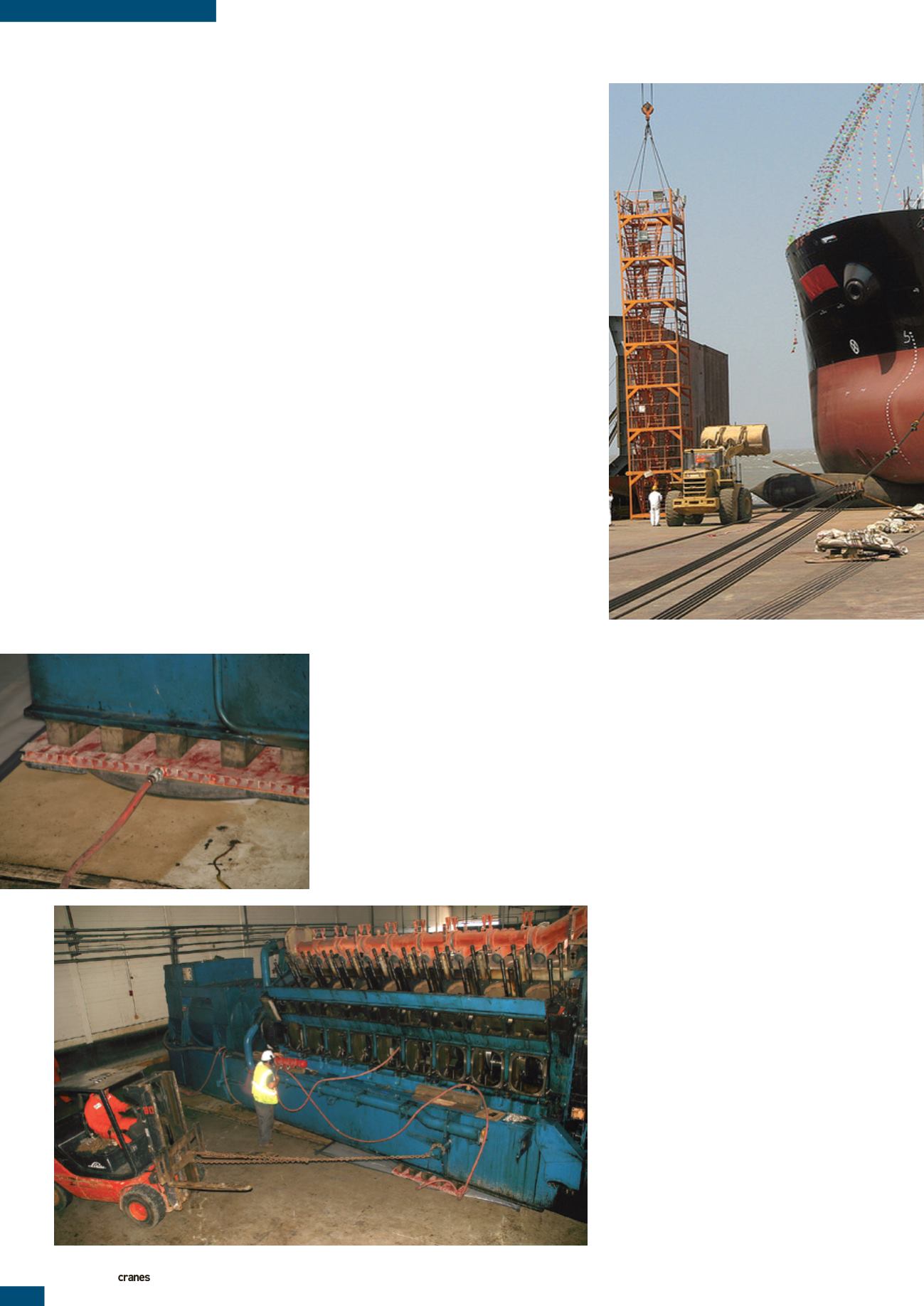
THE KNOWLEDGE
INTERNATIONAL AND SPECIALIZED TRANSPORT
■
OCTOBER 2013
42
era. The rolling of heavy loads is applied
on many projects. Picking up the logs,
however, and carrying them to the front
of the load is extremely labour intensive
and counter productive. A method where
the logs are tied together and the ones that
are ejected from the rear are automatically
transferred to and injected in the front
would eliminate much labour and increase
the reliability of such a system. Tank
rollers do just that and they are used in
many applications.
Turning a load, like turning the
pyramid block, becomes easier when the
friction between the load and the surface
it is sitting on is at its lowest. This can
be achieved with the introduction of a
friction reducing material, such as the
sand in the previous example.
In reality, any friction reducing material
will do, provided it is used on the right
base. Oil on steel, Teflon on stainless steel,
grease on hardwood, even regular liquid
dish washing detergent has been used to
move a 250 tonne generator into an engine
hall. All modern skidding systems and
turntables are based on this principle.
There is a specific application where a
log-like method is still used, pretty much
the way it was done in ancient times.
Launching boats, barges and ships from
a slope into the water can be achieved
with airbags. This method of launching
vessels is more commonly applied in the
Far East and is a fast way of launching
vessels, if done the right way. It requires
some detailed knowledge of the procedure
and the airbags in particular. Airbags
have a break-lose friction of 3 to 4 % of
the weight they carry. Thereafter (once
the vessel is moving) the dynamic friction
can be as low as 1 % or less if on a hard
subsurface. This means that the tie back
arrangement, to avoid a run-away vessel,
requires serious looking into. Airbags are
available from 1 to 2.5 metres in diameter
and up to 25 m long. Depending on the
airbag pressure they can easily weigh 400
or more tonnes each.
Calculating airbag capacity
Let’s assume that we have an airbag with
a diameter (D) of 1.2 m and a length (L)
of 15 m. The airbag pressure (P) is 4 bar
(400,000 N/m
2
) and, after placing a load
on it, the height (H) cannot be less
than 0.5 m.
The capacity, F, of this airbag is then,
(1.2 – 0.5) * 400,000 * 15 = 4,200,000
Newton, which equals roughly 420 tonnes.
The advantage of using airbags over a
load out with SPMT onto a submersible
barge is that airbags are cheaper and easier
to use, there is less mobilisation cost and
less investment. If it is already known
during the construction of a vessel that
airbags will be used for the launch, the
docking blocks (on which the vessel sits
while on shore) can be spaced in such a
way that the airbags can be inserted and
inflated, therewith lifting the vessel from
its docking blocks, ready to launch. The
airbags float and can be easily retrieved.
Disadvantages are the inability to make
corrections during the launch and the
necessity of building the vessel in front of
or on a launch ramp. If the ship building
company is building multiple vessels at the
same time, they will need multiple launch
ramps. The picture above shows an airbag
launch where the airbags can still be seen
on the bow of the vessel. The tie back
arrangement can also be seen.
Airbag issues
A problem with airbag launches is that
the launch ramp has to be designed and
built in such a way so the vessel can simply
float off the ramp while it enters the water.
Results of an incorrect ramp (too short,
incorrect or no angle) can be disastrous
for the airbags, the ramp and the vessel
being launched.
One often overlooked aspect of an
airbag launch is the tidal condition.
Launching at too low tide can result
in the vessel hinging on the end of the
launch ramp. The full weight (minus the
buoyancy) is applied to that hinging area
and buckling of the vessel becomes
a reality.
While on the subject of air assisted
moves, the air pallet has to be addressed.
An air pallet is a rigid place with an airbag
Air pallet system being used to move a large
engine in an industrial environment
Air pallet with the inlet hose for
compressed air and the rubber cushion


